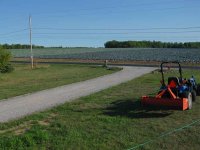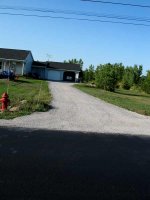From what I've learned, there are those who live in areas that get allot of snow and have extrem cold for long periods of time. They build there roads differnetly then those of us who don't get the cold weather that they do.
Rain is the same everywhere. Even if you don't get allot, one heavy rain can destroy more then anything else.
Step one is to get rid of the water. Drainage is why roads fail, it's what causes pot holes and it's what washes out gravel. The difference between areas with lots of rain and those that get minimal rain is how deep your ditches and culverts need to be.
Top soil will continue to decompose over time, so you want to remove it to stop the road from settling. I'm luck in that I don't have topsoil. It's all clay. If you have topsoil, you need to remove it down to a solid base. Then you need to fill in that area and build it up to a crown. The bigger the crown, the longer your road will last. This is where I see most people take shortcuts, and then come back trying to figure out how to fix there road. The crown must be higher then your drainage ditches when full of water.
Once you have all your dirt work done, you can put down rock. Most road base rock is the same, but with different names aroudn the country. It's a corse, angular rock with sharp corners. The bigger stones will be 2 inches in size, plus or minus a little. It will contain those size rocks, and every thing down to the very finest of dust. The reason for this is that it will compact and compress into a solid mass. It takes a minimum of four inches to make this happen. Anything less, and you will have movement. Movement will lead to the rock moving around and never becomeing solid. More is better, but there is a point when you are just wasting money. I feel that six inches is where this happens, but that's not gospel, just my opinion.
Once you get the rock down and spread out, drive over it. Over and over it, again and again. It will take weeks to get it really hard, but after a few hours, you might be ok for a light rain. Just keep driving over it in differet areas then the previous time.
After it's solid, the biggest mistake you can make is to run a box blade over it. You need that rock to stay solid, so it will shed water. The box blade breaks up the rock and moves it around. You will lose rock and you will make your base thinner. If you are over 4 inches, you can ruin some without any serious damage, but if you get it thinner then 4 inches, that part of the road will fail. Potholes will be your first clue, then getting stuck will be your second clue.
When the road needs more rock in a low area, buy more rock and fill in the low area. Draging rock from one are to fill in the low areas just means your sprading the rock around and creating more thin areas. I've seen it done more then once without any idea that they are ruining the road and increasing the amount of rock, and expense, that it will take to fix what should have been an easy repair.
Beside the railroads, look at National Forest roads if you have any around. They didn't mess around when they built them. They are all weather and built to last.
Eddie
 Should mention, the big stumps and rocks are already gone. Just me and the dust/mud.
Should mention, the big stumps and rocks are already gone. Just me and the dust/mud. 

